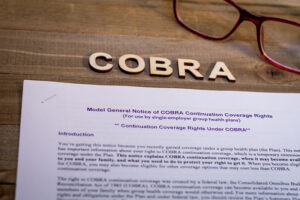What Employers Need to Know About COBRA Changes, Subsidies, Tax Credits, and Continuation Coverage Under the American Rescue Plan
 President Biden’s recently enacted American Rescue Plan of 2021 (ARP) includes significant changes to COBRA continuation coverage that impose new administrative responsibilities on employers. The centerpiece of the ARP’s COBRA-related employment law provisions is a 100 percent COBRA premium subsidy for “assistance eligible individuals” during periods of COBRA continuation coverage from April 1, 2021, through September 30, 2021.
President Biden’s recently enacted American Rescue Plan of 2021 (ARP) includes significant changes to COBRA continuation coverage that impose new administrative responsibilities on employers. The centerpiece of the ARP’s COBRA-related employment law provisions is a 100 percent COBRA premium subsidy for “assistance eligible individuals” during periods of COBRA continuation coverage from April 1, 2021, through September 30, 2021.
That subsidy means that employers and plan administrators must make eligibility determinations and apply for tax credits to compensate them for the premium assistance provided under the ARP, along with an extended election period that allows individuals who previously declined or discontinued COBRA coverage to elect coverage.
On May 18, 2021, the IRS issued Notice 2021-31, which contains extensive guidance for employers on their obligations related to the premium subsidies for continuation coverage. With 86 FAQs answered and a plethora of examples, the guidance is an indispensable resource for employers and administrators charged with implementing the subsidies and obtaining the corresponding tax credits.
The following are some fundamentals that employers must know about COBRA continuation coverage changes under the ARP.
“Assistance Eligible Individuals” Who Can Receive COBRA Premium Assistance Under the ARP
The 100 percent premium subsidy established by the ARP is only available to “assistance eligible individuals (AEP), defined as an individual who:
- Is a “qualified beneficiary” under COBRA due to involuntary termination of employment (other than for gross misconduct) or reduction of hours.
- Is eligible for COBRA coverage for some or all of the COBRA premium subsidy period (April 1, 2021, through September 30, 2021).
- Elects COBRA continuation coverage.
Otherwise eligible individuals cannot receive the premium subsidy if they can enroll in other group health coverage, such as through a new employer or a spouse’s plan, or if they are eligible for Medicare.
Additional COBRA Election Opportunity
Besides the 100 percent subsidy, the ARP establishes an “extended election period.” This allows individuals who previously declined or discontinued COBRA coverage to elect coverage and use the subsidy if they would be an Assistance Eligible Individual if enrolled in COBRA during the April 1, 2021, through September 30, 2021, subsidy period.
“Involuntary Termination”
Individuals who quit their jobs typically do not qualify for COBRA continuation coverage, which is why premium assistance is only available to those who lost their jobs due to involuntary termination (and those whose reduction of hours takes them off their employer’s plan). However, in a lengthy list of FAQs about the COBRA provisions of the ARP, the IRS recently clarified what constitutes “involuntary termination” for purposes of the subsidy.
Specifically, the IRS states that involuntary termination means:
“a severance from employment due to the independent exercise of the unilateral authority of the employer to terminate the employment, other than due to the employee’s implicit or explicit request, where the employee was willing and able to continue performing services.”
The FAQs issued by the IRS address several specific issues likely to arise when determining whether a termination was involuntary, such as workplace safety issues, the inability to obtain childcare, and retirement.
Determining Who Is an Assistance Eligible Individual
Employers were required to notify qualified beneficiaries about the availability of COBRA premium assistance and other information about their rights under the ARP by May 31, 2021.
For individuals who elect COBRA continuation in response to the required notice, the IRS guidance states that an employer may require them to provide a self-certification or attestation regarding their eligibility status (i.e., involuntary termination, reduction in hours, and non-eligibility for Medicare or other disqualifying group health plan coverage). While an employer does not need to require self-certification or attestation regarding eligibility status, an employer claiming a tax credit for that individual must retain records that substantiate their eligibility for the COBRA subsidy.
Notice 2021-31 allows an employer to rely on an individual’s self-certification or attestation for proof of eligibility unless the employer knows that the self-certification or attestation is incorrect. An employer may also rely on other evidence to substantiate eligibility.
Claiming Tax Credits for COBRA Continuation Coverage Subsidies
For each assistance-eligible individual who elects COBRA continuation coverage, an employer that pays premiums for its group plan is entitled to a tax credit equal to the premiums that would have been charged to that individual in the absence of the COBRA subsidy. However, the credit does not include any amount that the employer would have otherwise paid or contributed.
An employer payee can claim the credit by reporting the credit and the number of individuals receiving COBRA premium assistance on the designated lines of its federal employment tax return(s), typically Form 941, Employer’s Quarterly Federal Return.
Questions About COBRA Continuation Coverage Subsidies? We Have Answers.
As noted, the recent IRS guidance about the ARP’s COBRA-related provisions is lengthy, detailed, and nuanced. The information provided here is merely a broad overview. If you have additional questions regarding the ARP’s requirements regarding COBRA continuation coverage and your company’s obligations relating to subsidies, tax credits, or other issues, please contact the Employment Law Practice Group at Kreis Enderle today.